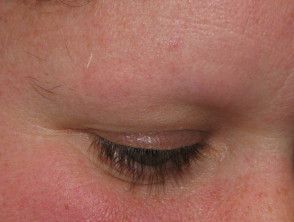- Case-Based Roundtable
- General Dermatology
- Eczema
- Chronic Hand Eczema
- Alopecia
- Aesthetics
- Vitiligo
- COVID-19
- Actinic Keratosis
- Precision Medicine and Biologics
- Rare Disease
- Wound Care
- Rosacea
- Psoriasis
- Psoriatic Arthritis
- Atopic Dermatitis
- Melasma
- NP and PA
- Skin Cancer
- Hidradenitis Suppurativa
- Drug Watch
- Pigmentary Disorders
- Acne
- Pediatric Dermatology
- Practice Management
- Prurigo Nodularis
- Buy-and-Bill
News
Article
Higher Scalp Hair Loss Linked to Noticeable Gaps or Absence in Eyebrow and Eyelash Hair in Patient Study
Author(s):
A poster analyzing the BRAVE-AA study population was presented at Maui Derm Hawaii 2024.
Higher severity of scalp hair loss among patients with alopecia areata (AA) was positively linked to more noticeable gaps or absence of eyebrow and eyelash hair, according to data presented in a poster at the Maui Derm Hawaii 2024 conference in Wailea, Hawaii.1
The study, conducted during the phase 3 trials BRAVE-AA1 and BRAVE-AA2,2 aimed to shed light on the distribution of eyebrow and eyelash hair loss across varying degrees of scalp hair loss severity in patients with severe AA.
Despite scalp hair loss being a well-known characteristic of AA, the impact on eyebrow and eyelash hair loss is often underestimated, adding to the psychosocial challenges faced by individuals with this condition, according to study authors.
The primary objective of the study was to provide a comprehensive description of the baseline distribution of eyebrow and eyelash hair loss in patients with severe alopecia areata across different degrees of scalp hair loss.
Adult patients with severe AA, as indicated by Severity of Alopecia Tool (SALT) scores ≥50 (≥50% scalp hair loss), were enrolled in the BRAVE-AA1 and BRAVE-AA2 trials.
The severity of eyebrow and eyelash hair loss was assessed using the Clinician-Reported Outcome (ClinRO) Measure for Eyebrow Hair LossTM (ClinRO Eyebrow) and the ClinRO Measure for Eyelash Hair LossTM (ClinRO Eyelash).
Scores ranged from 0/1 (indicating full coverage or minimal gaps) to 2/3 (representing significant gaps or no notable hair). Baseline ClinRO Eyebrow and ClinRO Eyelash scores were summarized by SALT scores across all randomized patients in both trials.
The study included patients with SALT scores ranging from 50-74 (n=338), 75-94 (n=220), and 95-100 (n=633). Among these groups, the proportions of patients with ClinRO Eyebrow scores of 0/1 and 2/3 were as follows:
- SALT 50-74: 58.6% (0/1) and 41.4% (2/3)
- SALT 75-94: 39.5% (0/1) and 60.5% (2/3)
- SALT 95-100: 12.8% (0/1) and 87.2% (2/3)
Similarly, the proportions of patients with ClinRO Eyelash scores of 0/1 and 2/3 were:
- SALT 50-74: 70.1% (0/1) and 29.9% (2/3)
- SALT 75-94: 54.1% (0/1) and 45.9% (2/3)
- SALT 95-100: 22.4% (0/1) and 77.6% (2/3)
The findings from the BRAVE-AA study population suggest a clear correlation between higher degrees of scalp hair loss and increased proportions of patients experiencing significant gaps or no notable eyebrow and eyelash hair, study authors wrote.
Disclosures: This study was sponsored by Eli Lilly and Company under license from Incyte.
References
- Shapiro J, Ko J, Egeberg A, et al. Baseline distribution of eyebrow and eyelash loss by severity of scalp hair loss in phase 3 trials of baricitinib for alopecia areata. Poster presented at: Maui Derm Hawaii 2024; January 22-26, 2024; Wailea, HI.
- Kwon O, Senna MM, Sinclair R, et al. Efficacy and safety of baricitinib in patients with severe alopecia areata over 52 weeks of continuous therapy in two phase III trials (BRAVE-AA1 and BRAVE-AA2). Am J Clin Dermatol. 2023;24(3):443-451. doi:10.1007/s40257-023-00764-w







